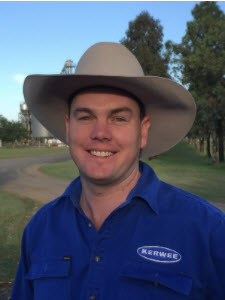Kerwee backs antimicrobial stewardship guidelines

Theme: People & the Community
Priority: Antimicrobial stewardship
Business: Kerwee Feedlot
Location: Darling Downs, Queensland
"We use antimicrobials responsibly but adopting the framework in the guidelines puts us in a position to continue to meet consumer expectations with potentially little or no change to our practices"
KEY POINTS
- Kerwee feedlot is establishing an Antimicrobial Stewardship (AMS) plan
- The plan is based on the Antimicrobial Stewardship Guidelines for the Australian Cattle Feedlot Industry
- Customers and consumers are becoming increasingly inquisitive about antimicrobial use in food production systems
- Industry is undertaking the stewardship program to preserve the continued use and efficacy of antibiotics to ensure livestock can be cared for.
Steve Martin, General Manager of Feedlot Operations at Kerwee Feedlot, Jondaryan, said the feedlot was working to establish an Antimicrobial Stewardship (AMS) plan based on the Antimicrobial Stewardship Guidelines for the Australian Cattle Feedlot Industry.
He said purchase strategies that allow and encourage pre-vaccination on-farm, minimising the co-mingling of cattle at feedlot entry and acclimating cattle into pens following induction, were among the specific steps Kerwee has in place to help prevent illness and minimise antimicrobial use.
“We background around 10% of our production on our property and a further 50% are pre-vaccinated and/or grouped into single lines prior to entry by suppliers,” Mr Martin said.
“Recording crush side temperatures, weight measurements and benchmarking animal pull rates and treatments in order to manage success of treatments and reduce re-treatment rates, all allow us to monitor total antimicrobial usage as a key performance indicator.”
Kerwee Feedlot on Queensland’s Darling Downs has a 20,200 head capacity, operating as part of the vertically integrated Kerwee Group, supplying Wagyu and long-fed Angus cattle for its Stockyard beef brands.
Mr Martin said the feedlot was at an advantage for reduced antimicrobial use, due to its long-fed program and the lower exposure to health risks.
“A large percentage of our occupancy is comprised of low-risk cattle because the structure of our feeding program means there’s low turnover, and a reduced risk of infections such as Bovine Respiratory Disease,” Mr Martin said.
The AMS Guidelines were developed by the Australian Lot Feeders’ Association (ALFA) using grainfed levies through Meat and Livestock Australia earlier this year. The guidelines arm feedlot managers with practical information on critical antimicrobial agents, antimicrobial resistance and provide a framework to ensure appropriate use of antimicrobials within feedlots.
ALFA Chief Executive Officer, Christian Mulders, said that preserving the effectiveness of current antimicrobials is crucial to sustainability of the red meat industry.
“Consumers are increasingly more focused on the integrity of our food production systems,” Mr Mulders said.
“Antimicrobial stewardship is allied with other vital priorities of the Australian Beef Sustainability Framework; it affects animal welfare, the health and safety of our people and, in the long run, the profitability of Australia’s red meat businesses.
“We’re encouraging adoption of the guidelines because they advocate the appropriate use of antimicrobials and demonstrate to our customers we use these animal health tools responsibly to take the best care of our livestock.
At Kerwee Feedlot, Mr Martin is more than happy to support industry guidelines.
“Social license can’t be bought, but it can be earnt,” Mr Martin said.
“We need to demonstrate that we have world leading management systems when it comes to responsible, clean and sustainable food production.
“This is our industry being proactive in maintaining consumer confidence in grainfed Australian beef.”
Categories: People & the community